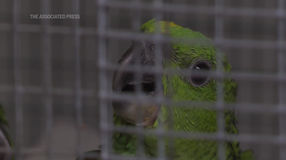

THE WAR ON WILDLIFE -- COMBATING ILLEGAL WILDLIFE TRADE




WILD PARROTS PAY THE PRICE
The illegal wildlife trade is a multi-billion dollar criminal enterprise that spans the globe. From rhinos to orchids, no species is exempt from slaughter, harvest, and illegal trade.
The illegal parrot trade is a harrowing tale of cruelty and devastation, unfolding across continents. It is estimated that over 500,000 parrots are snatched from their natural habitats and illegally transported and sold annually. Subjected to brutal capture methods and grueling transport conditions, many suffer injuries, trauma, and a staggering mortality rate (estimated at 75% - 80%). Beyond the individual suffering, the illegal trade in parrots wreaks havoc on wild populations, driving species towards extinction and disrupting delicate ecosystems. Forests are under siege as nest trees are cut to access chicks and eggs.
According to Bird Life International, in the Americas, the sale of wild-caught parrots still occurs in contravention of the Convention on International Trade in Endangered Species (CITES) and national laws that ban unauthorized trade in wild animals. A recent study of pet markets in Santa Cruz, Bolivia found that over 22,000 individuals of 31 parrot species, the vast majority of which (94%) were wild-caught, were illegally traded every year under Bolivian law. Similarly large numbers of wild-caught birds are traded illegally in Mexico, with trappers estimated to capture 65,000–78,500 parrots every year.
RSCF works with regulatory agencies and law enforcement to assist in the recovery and rescue of smuggled chicks and eggs, while also consulting with international governments and NGOs to expose and hold accountable criminal organizations involved in illegal wildlife trade.
2024
It is difficult to determine the exact number of parrots illegally trafficked worldwide in 2024, as the illegal wildlife trade is largely undocumented. However, several sources provide insight into the scale of the problem:
-
General trends:
-
Wildlife trafficking overall has not been significantly reduced in two decades and now affects over 4,000 species of animals and plants across more than 160 countries.
-
Demand for illegally acquired wildlife persists, with no signs of a slowdown in 2024.
-
-
Estimates for specific regions:
-
In the Americas, a study in Santa Cruz, Bolivia found that over 22,000 individuals of 31 parrot species, mostly wild-caught, were illegally traded each year under Bolivian law.
-
In Mexico, trappers are estimated to capture 65,000-78,500 parrots annually.
-
In the Democratic Republic of Congo, around 30-40 illegal shipments of Grey parrots are trafficked through Kinshasa each year, with at least 12,000 parrots transported to N'djili International Airport within the past 12 months.
-
-
Specific incidents and seizures:
-
In June 2024, 60 illegally trafficked parrots were transported back to their native Indonesia.
-
Nigerian authorities seized 36 illegally held African grey parrots in April 2024.
-
In May 2024, 113 smuggled parrots drowned when smugglers tossed their cages overboard during an interception by the U.S. Coast Guard.
-
In November 2024, more than 6,500 illegally trafficked birds, including endangered songbirds, were seized in Indonesia.
-
It is important to note that these figures likely represent only a fraction of the total number of parrots trafficked. The illegal parrot trade continues to be a major threat to wild populations and highlights the need for continued efforts to combat this global issue.
WILDLIFE TRADE NEWS
The following video and articles feature news related to the trade in parrot species.
Click the images for expanded view and news article links.








